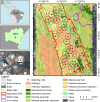Spatial heterogeneity regulates plant-pollinator networks across multiple landscape scales
- PMID: 25856293
- PMCID: PMC4391788
- DOI: 10.1371/journal.pone.0123628
Spatial heterogeneity regulates plant-pollinator networks across multiple landscape scales
Abstract
Mutualistic plant-pollinator interactions play a key role in biodiversity conservation and ecosystem functioning. In a community, the combination of these interactions can generate emergent properties, e.g., robustness and resilience to disturbances such as fluctuations in populations and extinctions. Given that these systems are hierarchical and complex, environmental changes must have multiple levels of influence. In addition, changes in habitat quality and in the landscape structure are important threats to plants, pollinators and their interactions. However, despite the importance of these phenomena for the understanding of biological systems, as well as for conservation and management strategies, few studies have empirically evaluated these effects at the network level. Therefore, the objective of this study was to investigate the influence of local conditions and landscape structure at multiple scales on the characteristics of plant-pollinator networks. This study was conducted in agri-natural lands in Chapada Diamantina, Bahia, Brazil. Pollinators were collected in 27 sampling units distributed orthogonally along a gradient of proportion of agriculture and landscape diversity. The Akaike information criterion was used to select models that best fit the metrics for network characteristics, comparing four hypotheses represented by a set of a priori candidate models with specific combinations of the proportion of agriculture, the average shape of the landscape elements, the diversity of the landscape and the structure of local vegetation. The results indicate that a reduction of habitat quality and landscape heterogeneity can cause species loss and decrease of networks nestedness. These structural changes can reduce robustness and resilience of plant-pollinator networks what compromises the reproductive success of plants, the maintenance of biodiversity and the pollination service stability. We also discuss the possible explanations for these relationships and the implications for landscape planning in agricultural areas.
Conflict of interest statement
Figures



Similar articles
-
The human touch: a meta-analysis of anthropogenic effects on plant-pollinator interaction networks.PeerJ. 2024 Jun 27;12:e17647. doi: 10.7717/peerj.17647. eCollection 2024. PeerJ. 2024. PMID: 38948210 Free PMC article. Review.
-
Potential landscape-scale pollinator networks across Great Britain: structure, stability and influence of agricultural land cover.Ecol Lett. 2018 Dec;21(12):1821-1832. doi: 10.1111/ele.13157. Epub 2018 Sep 17. Ecol Lett. 2018. PMID: 30223295
-
Forest and connectivity loss simplify tropical pollination networks.Oecologia. 2020 Feb;192(2):577-590. doi: 10.1007/s00442-019-04579-7. Epub 2020 Jan 2. Oecologia. 2020. PMID: 31897723
-
Ecosystem restoration strengthens pollination network resilience and function.Nature. 2017 Feb 9;542(7640):223-227. doi: 10.1038/nature21071. Epub 2017 Jan 30. Nature. 2017. PMID: 28135718
-
The future of plant-pollinator diversity: understanding interaction networks across time, space, and global change.Am J Bot. 2011 Mar;98(3):528-38. doi: 10.3732/ajb.1000391. Epub 2011 Feb 10. Am J Bot. 2011. PMID: 21613144 Review.
Cited by
-
Structural stability estimated through critical perturbation determines evolutionary persistence in mutualistic model ecosystems.R Soc Open Sci. 2025 Aug 6;12(8):250123. doi: 10.1098/rsos.250123. eCollection 2025 Aug. R Soc Open Sci. 2025. PMID: 40771661 Free PMC article.
-
Impacts of deforestation on plant-pollinator networks assessed using an agent based model.PLoS One. 2018 Dec 31;13(12):e0209406. doi: 10.1371/journal.pone.0209406. eCollection 2018. PLoS One. 2018. PMID: 30596693 Free PMC article.
-
Asynchrony in coral community structure contributes to reef-scale community stability.Sci Rep. 2023 Feb 9;13(1):2314. doi: 10.1038/s41598-023-28482-7. Sci Rep. 2023. PMID: 36759628 Free PMC article.
-
The human touch: a meta-analysis of anthropogenic effects on plant-pollinator interaction networks.PeerJ. 2024 Jun 27;12:e17647. doi: 10.7717/peerj.17647. eCollection 2024. PeerJ. 2024. PMID: 38948210 Free PMC article. Review.
-
Pollination networks along the sea-inland gradient reveal landscape patterns of keystone plant species.Sci Rep. 2018 Oct 15;8(1):15221. doi: 10.1038/s41598-018-33652-z. Sci Rep. 2018. PMID: 30323249 Free PMC article.
References
-
- Hagen M, Kissling WD, Rasmussen C, Aguiar MAM De, Brown LE, et al. Biodiversity, Species Interactions and Ecological Networks in a Fragmented World. Adv Ecol Res. 2012; 46: 89–210.
-
- Morales JM, Vázquez DP. The effect of space in plant-animal mutualistic networks: insights from a simulation study. Oikos. 2008; 117: 1362–1370.
-
- Ferreira P alves, Boscolo D, Viana BF. What do we know about the effects of landscape changes on plant—pollinator interaction networks? Ecol Indic. 2013; 31: 35–40.
-
- Aguilar R, Ashworth L, Galetto L, Aizen MA. Plant reproductive susceptibility to habitat fragmentation: review and synthesis through a meta-analysis. Ecol Lett. 2006; 9: 968–980. - PubMed
Publication types
MeSH terms
LinkOut - more resources
Full Text Sources
Other Literature Sources

